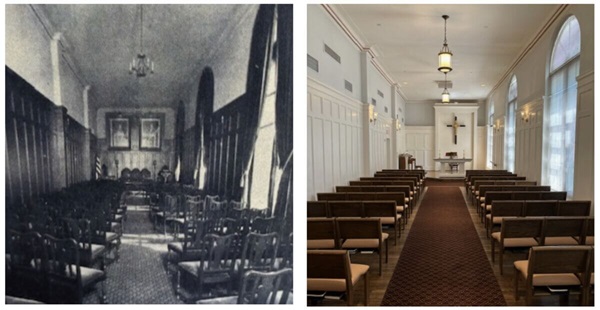ON THIS DAY SERIES... Each month in 2024, Church and Society is highlighting notable days offering glimpses into the momentous 100-year history of The United Methodist Building (1924 - 2024) and the people called Methodists often walking along side ecumenical partners living their faith through social witness.
On August 14, 1929, after months of planning, the construction of The Simpson Memorial Chapel in The United Methodist Building replaced the original bookstore.
Located on the first floor of the United Methodist Building, the Simpson Memorial Chapel has been a consistent place of prayer, worship, ecumenical gathering, and hospitality on Capitol Hill for decades.
In honor of their father, Bishop Matthew Simpson, Ida and Sarah Simpson funded the planning and construction of the Simpson Memorial Chapel in 1929.
The original dedication of the Chapel was to both Bishop Matthew Simpson and his wife Ellen with an opening prayer that said: “We are thankful to Thee for this occasion which brings us together to dedicate this Chapel in memory of Bishop and Mrs. Simpson, for what they were able to do for our Church and our Nation through the grace and power of Thy spirit.”
Bishop Matthew Simpson (1811-1884) was elected bishop of the Methodist Episcopal Church in 1852. Serving from Philadelphia, he preached all over the country galvanizing Northern views of anti-slavery and Union patriotism before and during the civil war.
Bishop Simpson was a gifted orator, educator and influential leader among Republican party officials. On many occasions, President Abraham Lincoln secretly attended Simpson’s sermons in Philadelphia and Washington D.C., avoiding any Presidential public disruption. Simpson often visited the Lincoln White House and became a trusted friend and advisor, and according to many historians, contributed greatly to Lincoln’s Emancipation Proclamation.
On the night of President Lincoln’s assassination, April 14, 1865, Bishop Simpson was summoned by members of Lincoln’s cabinet to be with the family. He was with the family when President Lincoln died the next morning and he was chosen to pray and deliver the eulogy at Lincoln’s funeral in Springfield, IL.
To many who have worshipped in the Simpson Memorial Chapel, it is known as a house of prayer and politics. Over the decades, this sanctuary has served as a safe place for prayer, worship, inspiration, advocacy, celebration, comfort, lament and healing.
It has been a place of gathering to call out social justice and recognize actions for peace, and it has been a unifying space for leaning on God during very difficult moments.
One of the most remarkable Simpson Memorial Chapel stories of comfort and healing occurred in 2002. After a plane crash killed Sen. Paul Wellstone, his wife Sheila, daughter Marcia, two Capitol Hill staff, and two crew members, a memorial service was held in Simpson Memorial Chapel. The service was so crowded that a second service was quickly organized for an hour later combining people of all walks of life demonstrating compassion, love and support.
Today, in the spirit of Bishop Matthew Simpson, the Chapel continues to serve as a prayerful place for those faithfully working for peace, justice and the social witness of Jesus Christ.
ON THIS DAY SERIES… Each month in 2024, Church and Society is highlighting notable days offering glimpses into the momentous 100-year history of the United Methodist Building (1924 - 2024) and the people called Methodists often walking along side ecumenical partners living their faith through social witness. Originally published by Church and Society. Republished with permission by ResourceUMC.

